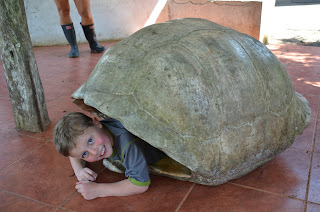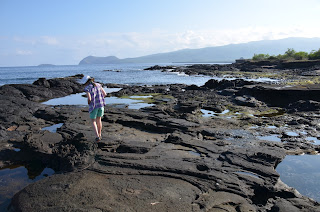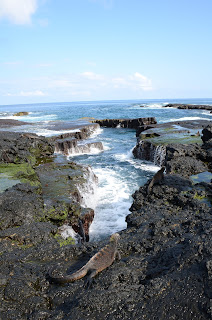February 2013, the adventure continues in South America. Follow Michael, Sara, Quinn and North to the Amazon jungles and Galapagos Islands of Ecuador.
Monday, February 25, 2013
On our way home...
After sailing back to San Cristobal Island, Sunday morning we left the Flamingo I and went ashore on the pangas for the last time starting our long journey home. We flew from the Galapagos back to Quito and had a long 8-hour layover in the the new Quito International Airport (it opened 3 days ago). Then we took a "red eye" flight that left Quito a little after midnight and arrived in Atlanta at about 6:00 a.m. on Monday morning. We are now in Salt Lake City waiting to board a plane on the final leg of our Ecuadorian adventure. What a trip! What an experience!
Santa Cruz Island and the Darwin Research Station
We spent our last day of touring on Santa Cruz Island. Santa Cruz is where the Darwin Research
Station is located, a research facility that studies the unique species that
are endemic to the Galapagos Islands and, in particular, is working to preserve
the Galapagos giant tortoise. We also
took a bus tour to view some unique geological features, including large collapsed
magma chambers and underground lava tubes from past volcanic activity on the
island.
We had a relaxing afternoon shopping in the Puerto Ayora,
the largest community in the Galapagos.
 |
| "Saddleback" Giant Tortoise |
 |
| Baby tortoises at Darwin Research Station |
 |
| Underground Lava Tube |
 |
| Port Ayora Harbor |
Santiago and Rabida
After an overnight cruise, we spent Friday off of Santiago
Island and a very small island known as Rabida Island. On Santiago we spent the morning walking
through an area of unbelievably beautiful tidal pools. The area is covered by
old lava flows. The volcanic rock has many large pockets and holes that fill
with water as the tide goes out. We saw
a variety of more colorful marine iguanas. We also saw sea lions, Galapagos fur
sea lions, blue footed boobies and a variety of other birds.
We spent the afternoon snorkeling off of Rabida Island. Unfortunately we couldn’t capture this
afternoon with pictures since it was spent under water, but it was spectacular,
the best day of deep water snorkeling we experienced. The water was warm and crystal clear. We saw countless varieties of colorful
tropical fish. We had sea lions swimming
and playing around us, and we caught a couple glimpses of white tip reef sharks
swimming by. Awesome!
Before dinner we took a short hike on shore before another
relaxing dinner on board the Flamingo I.
Isabella – Elizabeth Bay and Tagus Cove
On Thursday we spent the morning off the coast of Isabella
Island touring Elizabeth Bay on the pangas.
A portion of the bay is covered by shallow water
bordered by Mangrove Trees which provides great habitat for all sorts of birds
and marine life. We saw Blue Footed
Boobies, Galapagos Penguins and Brown Pelicans.
We also saw sea turtles, sea lions, many fish, and we saw a group of
golden rays cruising through the shallows.
In the afternoon, after a short mid-day navigation, we
anchored in protected bay called Tagus Cove.
Tagus Cove was named for a United States war ship that used the cove for
a hideout during World War II. We hiked a trail that took us up to a divide where we could look across to the other side of the island, and we also got a good view of a beautiful lake. The lake was found by Charles Darwin when he visited the islands. He thought he had found a source of fresh water, which are rare in the Galapagos, but he was disappointed to find that it is in fact a salt water lagoon with water three times saltier than sea water.
 |
| Brown Pelican |
 |
| Blue Footed Booby |
 |
| Cruising the mangroves |
 |
| Galapagos Penguins |
 |
| Penguin |
 |
| Golden Rays |
 |
| Scouting |
 |
| Sea Turtles |
 |
| Salt water lake with Tagus Cove in the background |
 |
| Top of the divide on Isabella Island |
Sunday, February 24, 2013
Fernandina and Isabella
Fernandina and
Isabella
These islands are obviously named for the Spanish monarchs,
King Ferdinand and Queen Isabella. All of the islands in the Galapagos were renamed with Spanish names when Ecuador was colonized by Spain. Ecuador later earned its independence but the Spanish names are still in use. However many maps list both the Spanish and original Ecuadorian names.
Isabella is the largest island in the Galapagos, and Fernandina is the
youngest. In fact, Fernandina is still
being formed. The volcano that formed Fernandina erupted most recently in 2009.
The resulting lava flows formed large new portions of coastline as it cooled
and hardened, including the area we walked this morning.
Our morning walk on Fernandina took us through an area where
thousands of Galapagos marine iguanas were nesting and sunning themselves. These prehistoric looking lizards are big and
look like they could be vicious with teeth and huge claws. However, they are herbivores that eat algae
and seaweed and are quire docile. Their
mean prehistoric faces were actually used as the model for the recent Godzilla
movie.
In the shallow tidal areas, we saw a tremendous amount of marine life. We stood and watched as two sea lions swam and played within a few feet of us. In the same pool we also saw a huge sea turtle swimming and eating. We saw several Flightless Cormorants, a flightless sea bird that is unique to the Galapagos, a Galapagos hawk, and also the famous Darwin Finch, which played a pivotal role in Darwin’s studies that led to the theory of evolution by natural selection.
We then returned to the Flamingo I, donned our wetsuits, and went for a deep water snorkel. In addition to the many tropical fish, we were able to swim with several sea turtles that came close enough to touch.
In the afternoon, we sailed to Isabella. While the kids stayed and played on the beach, the adults in the group went for a hike where we saw some great examples of large Galapagos giant tortoises and some large land iguanas.
After returning to the boat, we set sail for our next island destination and watched the sun set as we cruised.
 |
| Iguana mine field |
 |
| Marine Iguanas in the sun |
 |
| Iguana and Lava Lizard |
 |
| Galapagos Hawk |
 |
| Darwin Finch |
 |
| Flightless Cormorant |
 |
| Sea Lion |
 |
| Sandersons with Marine Iguanas |
 |
| Sea Turtle |
 |
| Swimming Iguanas |
 |
| Blue Footed Booby |
 |
| Lava field on Fernandina |
 |
| Crab eating iguana |
 |
| Giant tortoise walking on trail |
 |
| Land iguana. Nice claws! |
 |
| Tortoise and Iguana |
 |
| Land iguana eating in green plants |
 |
| Kids on the beach |
 |
| Galapagos sunset |
Life On Board Ship
Life on board ship is a fun adventure in itself. The Flamingo I has four decks. The main deck has the crew quarters, a
kitchen, a large dining area and a lounge.
The lower deck, which is below water level, has several guest cabins in the
front half of the boat; this is where our cabins are located. The upper deck
includes the bridge at the front, where the captain steers the boat, and
several more guest cabins. Above that, the top deck is called the sun deck, an
open air deck for relaxing and watching for marine life during our
cruises. The boat can hold about 20
guest passengers and it has a crew of 11.
Each day we have a daily briefing when our guides tell us
the schedule for the day and what supplies we need for each of our excursions.
At our first briefing, we were instructed on how to take a
“navy shower.” Since we have to carry
all of our fresh water for the trip on board the boat, it is important to
conserve as much water as possible. We
all had to take navy showers, which involved turning on the shower just long
enough to get wet. Then you turn off the shower while you lather up with soap
and shampoo, and then you turn the water back on long enough to rinse the soap
off.
The biggest thing to get used to on board the boat is the
constant rocking and rolling of the boat as it bobs along with the ocean
waves. It takes some getting used to,
but eventually you get your “sea legs” and you hardly notice the constant ups
and downs of the ocean.
 |
| The main lounge |
 |
| Dining Room |
 |
| Quinn at the helm |
 |
| North on his bunk |
 |
| Quinn reading on the sun deck |
 |
| Kids playing games on the sun deck during an afternoon cruise |
 |
| Our guide Ivan and our singing captain Victor |
 |
| The Booby Band |
 |
| Flamingo I |
Subscribe to:
Comments (Atom)














